

Log Off Successful. Sheep art project. Drawing sheep may seem like the easiest animal in the world to draw, but I found that they can pose a few problems for little ones.
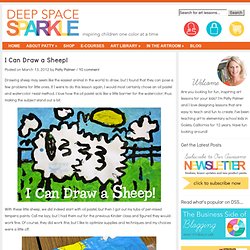
If I were to do this lesson again, I would most certainly chose an oil pastel and watercolor resist method. I love how the oil pastel acts like a little barrier for the watercolor, thus making the subject stand out a bit. With these little sheep, we did indeed start with oil pastel, but then I got out my tubs of per-mixed tempera paints.
Call me lazy, but I had them out for the previous Kinder class and figured they would work fine. Of course, they did work fine, but I like to optimize supplies and techniques and my choices were a little off. The problem can start in the drawing. We painted the background first, then the sheep. Regardless, the sheep project really was fun and the kids enjoyed it every step of the way. Share. Fun with Paper Art Lesson Plans. I love paper: craft paper, painted paper, wrapping paper, colored paper…I love it all!
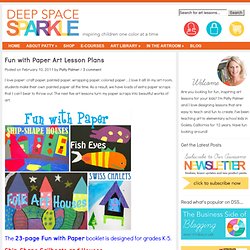
In my art room, students make their own painted paper all the time. As a result, we have loads of extra paper scraps that I can’t bear to throw out. Sunset Silhouette Art Project. These stunning silhouettes were created by third grade students.
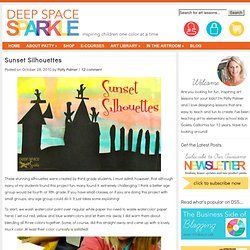
I must admit, however, that although many of my students found this project fun, many found it extremely challenging. I think a better age group would be fourth or fifth grade. If you have small classes, or if you are doing this project with small groups, any age group could do it. It just takes some explaining! To start, we wash watercolor paint over regular white paper (no need to waste watercolor paper here). Tree Study Art Lesson. Black and White Tree Study Posted on April 7, 2011 by Patty Palmer / 6 comment Fourth grade students practiced brush techniques last week.
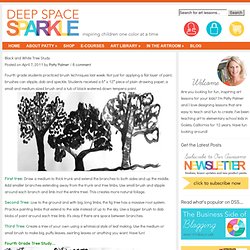
Not just for applying a flat layer of paint, brushes can stipple, dab and speckle. James Rizzi Art Lessons. Artist James Rizzi has been providing my art students with fabulous inspiration this Fall.
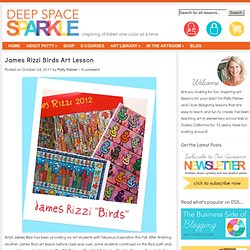
After finishing another James Rizzi art lesson before class was over, some students continued on the Rizzi path and created these adorable birds. The 2012 James Rizzi Wall Calendar (English, German, French, Italian, Spanish and Dutch Edition) is a great visual aid for this lesson, so if you don’t have any “Rizzi” art, this is a good place to start. This is what we did: We drew a very simple line drawing of Rizzi’s famous bird image on a 9″ x 12″ piece of watercolor paper. Use pan watercolor or liquid watercolors (easier) and paint the bird first. Joan Miro Art Lesson. Joan Miro, a Spanish artist who studied in Paris, is best known for his whimsical abstracts.
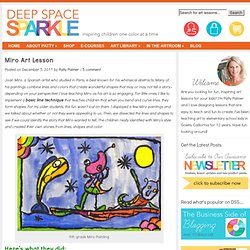
Many of his paintings combine lines and colors that create wonderful shapes that may or may not tell a story–depending on your perspective! I love teaching Miro as his art is so engaging. For little ones, I like to implement a basic line technique that teaches children that when you bend and curve lines, they form shapes. For my older students, the fun wasn’t lost on them. Georgia O'Keeffe inspired Art Lesson. This Georgia O’Keeffe inspired art lesson is quick, easy lesson that all grade levels will enjoy.

Needing a one-lesson project for the end of my sixth grade art rotation, I was inspired by an O’Keeffe art print on my wall. But instead of focusing on the center of a flower and creating a detailed drawing, I thought it might be fun to jazz up Georgia with some graphic qualities! Poinsettia Art Lesson. This is one of my most favorite art lessons to do this time of year.

It originated from an Arts and Activities article entitled “Poinsettia Perfection” by Temple Skelton Moore. I’m so grateful to Temple for providing one of the most accessible art lessons ever. Modern Masters Art lessons. Modern Masters introduces children to the wonderful world of Van Gogh, Cézanne, Chagall and Matisse.
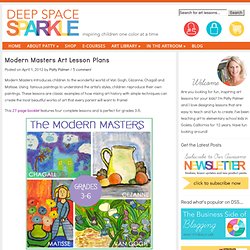
Using famous paintings to understand the artist’s styles, children reproduce their own paintings. These lessons are classic examples of how mixing art history with simple techniques can create the most beautiful works of art that every parent will want to frame! This 27-page booklet features four complete lessons and is perfect for grades 3-6. The booklet includes: An introduction to each artist and their paintingsDetailed steps to draw and paint in a student-created photo-tutorial (no adult art here!) Van Gogh Landscape Art Lesson. Van Gogh’s “Wheat Fields with Cypresses” is one of my favorite paintings.
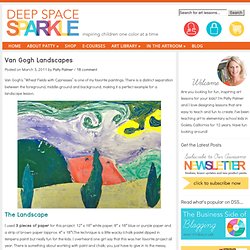
There is a distinct separation between the foreground, middle-ground and background, making it a perfect example for a landscape lesson. The Landscape I used 3 pieces of paper for this project: 12″ x 18″ white paper, 8″ x 18″ blue or purple paper and a strip of brown paper (approx. 4″ x 18″).The technique is a little wacky (chalk pastel dipped in tempera paint) but really fun for the kids. I overheard one girl say that this was her favorite project all year. There is something about working with paint and chalk; you just have to give in to the messy, sticky nature and enjoy the process. Using a pencil, draw a curvy line on the brown paper to represent the foreground. Starting with the sky, dip chalk into either white or colored tempera paint to create swirling lines. You can either use a colored piece of chalk dipped into white tempera, or white chalk dipped in colored tempera.
Kandinsky inspired art lesson for kinders. Judging by the intensity of my kinder class faces, I gathered they enjoyed this art lesson a great deal. The goal is to teach the children color-wheel basics. Begin with three colors of paint (red, yellow and blue) and see what happens. It’s really not about blending the paint perfectly, it’s really just about blending to see what happens. James Rizzi Art Lesson for Kids. James Rizzi has left his mark on the world. His amazing illustrations has made an indelible impression on me and my students. Last Fall, my sixth graders did a unit on James Rizzi which included Faces and Simple Birds. This time we had fun with James Rizzi Inspired Skyscrapers. This is a super easy lesson for older students. 100% fun and successful. The technique is simple: oil pastel and watercolors. For inspiration and drawing guidelines.
I think it’s important to use watercolor paper, no matter what the quality, as that is what makes the project so vibrant. African Art Lesson Plans. Inspired by the cultures of Africa, this 21-page booklet offers four lessons for the early elementary student. Using basic supplies (colored paper, oil pastels, tempera paint and waterproof markers) you’ll find all of these lesson simple, fun and educational. Lesson #1 African Huts Colorful mud huts are created using paper and pastel then placed upon a radiant painted sunset.Children learn composition, pattern and perspective. Brown Bear Brown Bear What Do You See Art Project. This is an adorable, skill-loaded art project that you can do with your little ones.
The book Brown Bear, Brown Bear What Do You See? Is a perennial favorite in Kinder classrooms. The book is about as perfect as you can get but strangely enough, really hard to incorporate into an art lesson. Modern Masters Art lessons. Painted Pumpkin Art Lesson. Looking for a quick, theme-based October art lesson for Kinders? This adorable pumpkin art project teaches cutting and pasting skills as well as color mixing. Tina via Artsy_T Flickr fame created this lesson that has been enjoyed by many. This is my Kinder classes version… Drawing the Pumpkin Hand out a sheet of 12′ x 18″ orange construction paper to each child. Painting the Pumpkin Set out three tubs of paint (either in plastic containers or 6-well palettes). Cut out the Pumpkin & Add the Funny Face Once dry, cut out the pumpkin shape.
Liberty Bell Art Project. Watercolor castle art project. My Kinder students joined in on the fairy tale fun by learning how to turn lines and shapes into a castle. By combining squares, rectangles, triangle and a few half circles, Kinders created their very own castle. You don’t need many supplies; a 12″ x 18″ piece of regular drawing paper, some liquid watercolors and some oil pastels. I like to start the drawing with a simple line. American Flag Art Project. Best and Worst Art Lessons. Mister Seahorse Art Lesson. Line Drawing Art Lessons. Hundertwasser Art Lesson. Hundertwasser is inspiring. Ceramic pig art project. It’s never to early to teach little children how to make a basic pinch pot because when they master one, they can make just about anything in ceramics. This little pig is two pinch pots scored together, with added legs, head, snout and in this case, a curly tail. Ceramic Flower Dishes. While two of my Kinder classes (ages 5-6) created Ceramic Fish Dishes, my other Kinders created beautiful flower dishes.
The children used the same steps to create their flower dishes using the same clay and underglazes. There have been lots of suggestions from readers to try different glazes for ceramic projects and I have to admit, I’m very curious to try two: Mayco Stroke and Coat and Creatable Colors by Laguna. Apparently, you only need apply one coat of color to achieve a shiny glaze. This means only one firing if you apply the underglaze directly to the greenware. About applying underglaze to wet clay. Ceramic Fish Art Project. There is nothing more rewarding than manipulating a big slab of clay into a shiny piece of art.
Despite ceramics requiring a great deal of prep, it’s really the most wonderful of all the tactile art lessons. How to draw a robot. Pen and Watercolor Bird Art Project.